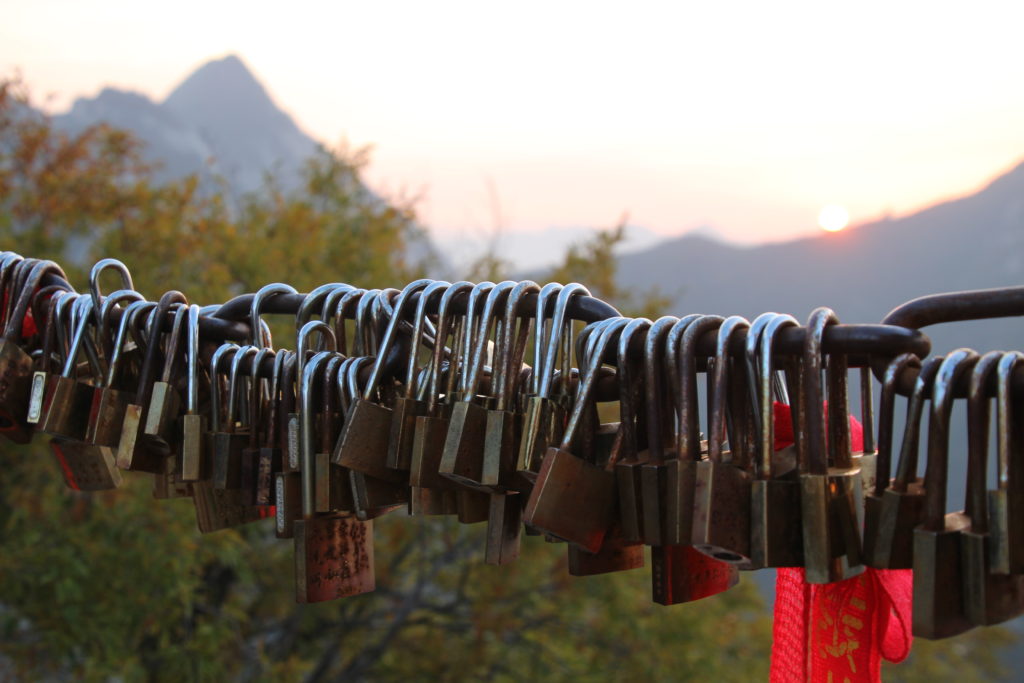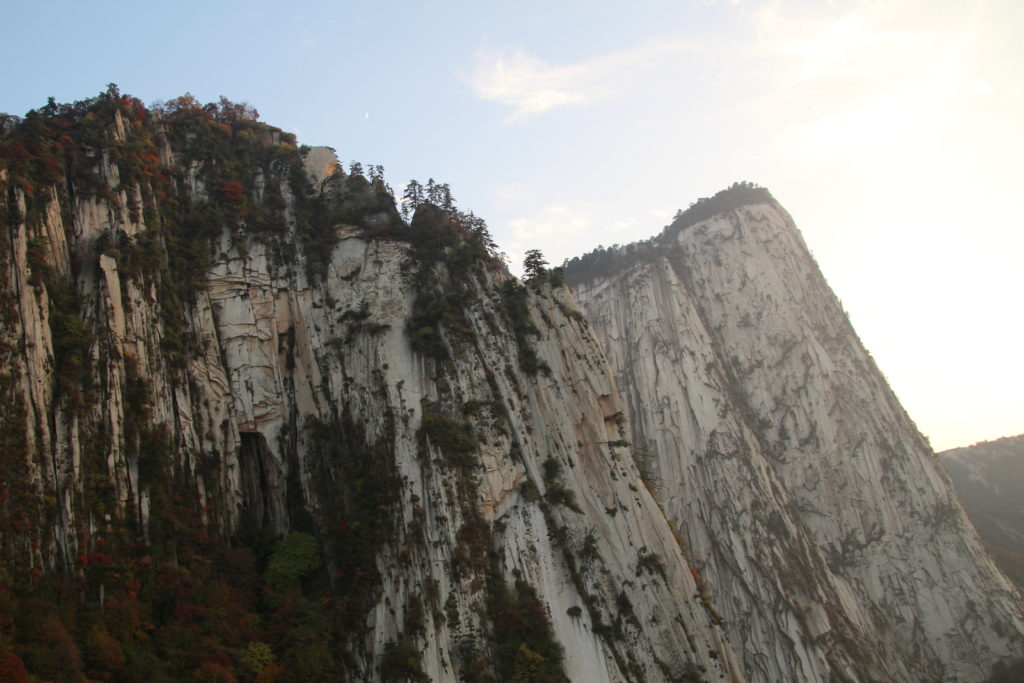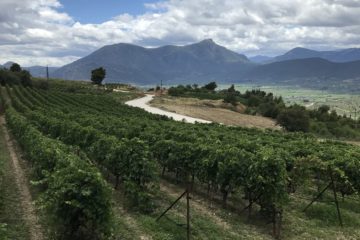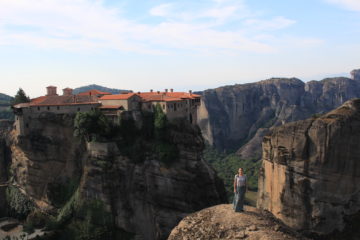When the easiest part of your day is waking up in the morning, you know it was a fairly rough day. That’s exactly what we confronted when we tried to take a daytrip from Xian to the nearby Huashan Mountains. Buckle up for a ride. [Editor’s note: technically, “Hua Shan” already means “Hua Mountain”, so “Hua Shan Mountain” is redundant. But hey, that’s what most westerners call it (as well as the English language signs in China), so that’s the name we’ll use. Also, this post contains a lot of pictures, but they come a little later in the story. Stick with us!]
The mountains are located roughly 2 hours outside Xian and there are several transportation methods for getting there, so we knew we had to do a bunch of research to really make sure we nailed down the logistics. Unfortunately, our efforts for the whole day were torpedoed by 9:15am by my incorrect research, mainly because I’m a moron. We went to the Xian Railway Station with the plan to catch one of the frequent 30 minute long high-speed trains to the mountains, only to be told (after going through security and waiting in line at the ticket counter) that we were at the wrong train station. We needed to be at the Xian NORTH Railway Station, which we didn’t even know existed at that point. The next train from our station wasn’t until 11:30am and would take two hours. Crap.
We tried to be nimble and roll with the situation, remembering a sign that mentioned that there were also buses nearby which departed for the mountains – they’d also take 2 hours, but left far more frequently and would get us there earlier. We scrambled to the bus station, which involved several wrong turns since the bus station wasn’t labelled in English at all (naturally). We managed, by some Baby Jesus-level miracle, to acquire tickets, find the right bus and get our seats – all without speaking any English or seeing any English signs. Seemed like we were on track, right? Nope.
After a two hour ride, we managed to get to the mountain. Hooray! Sorta. We were dropped on a normal town street, lined with shops and restaurants, but nothing that clearly indicated anything related to the actual tourist site of the mountain that we could see. After much gesturing and pantomiming of hiking movements (Need a visual? It’s basically a cross between someone doing the running man dance move and the gestures my Yiayia would make when she told me I needed to workout because I was getting fat. Got it? Good.), folks directed us up a hill to where we believed we’d be able to access the mountain. We scrambled up copious amounts of steps (“Wow, there’s a lot of hiking to get to the ticket office to be able to hike!”) to finally reach a ticket booth, only to realize our mistake – it was fool’s gold. While technically correct, it wasn’t what we needed. This was the entrance point for the trail to hike for 5 hours directly uphill to get to the top of the mountain, rather than the point where you catch one of two cable cars up to the top. [Editor’s note: we knew there was a lot of hiking once you got to the top of the mountain, connecting all the 5 peaks, so we had planned to forego the actual hike up the mountain in the first place. Given the time of day at this point (later than we wanted) and the amount of walking we knew was ahead anyway (too much), there was no way I was about to start this hike despite us being at the trailhead. Also, why wouldn’t they put the ticket booth, maps, etc. at the actual *bottom* of the mountain?!]
Realizing our error, we hastily backtracked to the main road (again, totally devoid of signage or indications of how to access the cable car) and began to hit panic mode. What the hell were we going to do? We approached a police station, hotel, fast food joint and random pedestrians to ask for directions – pointing to the map in our hand and a picture of a cable car, asking how we get there – only to receive conflicting answers from each. At this point, we’re fried – Jess is about to (justifiably) break down in tears, I was frazzled and upset, and we were both incredibly hangry. Never a good combination. [Editor’s note: one of the more defeating moments was when two consecutive people we asked seemed to both know how to get to the cable car…only it involved them pointing in opposite directions. Sigh.]
We managed to collect ourselves, solving each of these problems individually. To fix the brutal hunger, we snagged chicken sandwiches from a nearby joint – it seemed like our least pressing concern at the time, but it made a huge difference. To fix our logistical problem, we decided to throw money at the problem and just take a leap of faith – find a taxi driver, point to the same items (the map and picture), pay whatever he wants and just pray he gets us to the right point. Thankfully, it worked! He took us down the road to the main entrance where we could get the bus to the cable car, for only about $1.50 USD. As for our anxiety, nerves and mental exhaustion, I decided to call in critical reinforcements that Jess wouldn’t expect – Jay-Z and Kanye. Our spirits were sufficiently lifted after listening to some music, mouthing the lyrics and dancing in our seats in the bus ride up to the cable car in order to lift the haze over us. We were back on track!
[Editor’s note: Rorie makes this sound too easy. In typical Chinese fashion, the cab dropped us off about a 15 minute, mostly un-signed walk to the actual ticket office, which only sold tickets for the bus to the cable car, not the cable car itself. Those tickets are available at another ticket office, which itself is a long walk up a bunch of stairs from where the bus drops you off. On top of all of that, the tickets for the cable car could only be purchased from a machine that accepted Alipay or Wechat pay, two mobile methods in China that of course we didn’t have. After looking at the woman taking the tickets with helpless dismay, she offered to buy our tickets from the machine for us if we could give her cash. This is one time I wouldn’t have minded having a guide to take care of all this for us.]
[Note to the Editor’s Note: Jess makes a good point. This whole exchange she described was ridiculous. It was yet another moment where we were left saying to each other “everything is the hardest thing in the history of things.” It was also one of many moments where we were left to just exclaim, in exasperation, “China, I desperately just want to give you all our money for the thing, so why are you making it so damn difficult?!”]
It was all worth it, however, as soon as we got on the cable car, which covered an incredible distance, swooping up and down from one mountain to another at extremely steep angles, providing phenomenal views of the mountains through the nearby fog/smog. Jess bounced around the cable car like a small child hopped up on sugar, as she gleefully took in the views and snapped pictures of the breathtaking mountains with her fancy camera. I felt enough happiness in that moment to feel that all the earlier travails were not in vain.
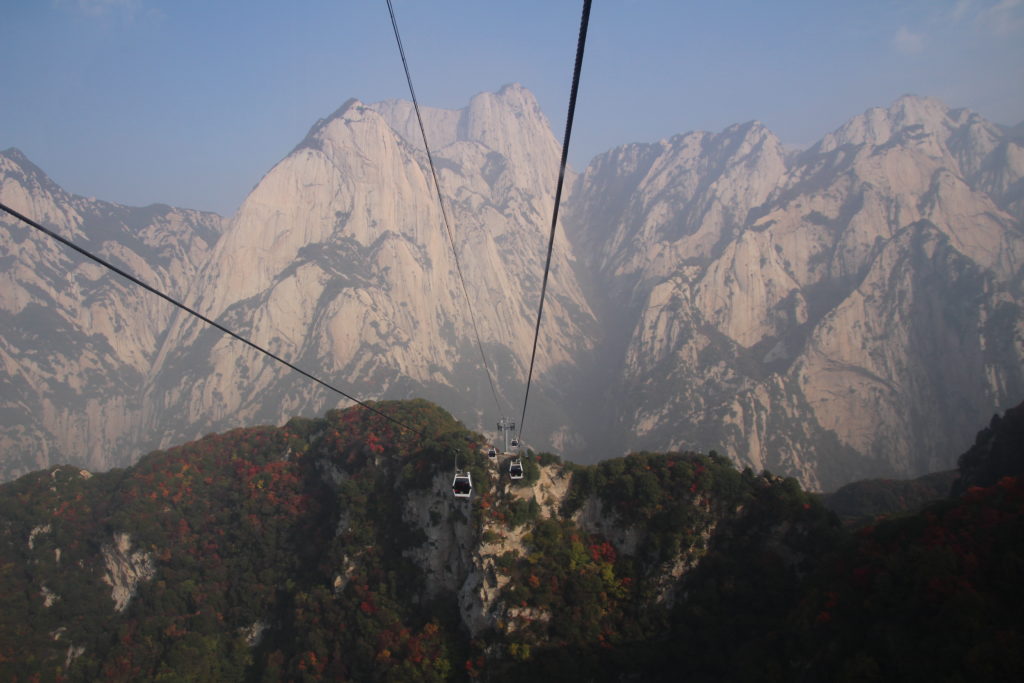
How’s that for a cable car view?

Worth the trouble to get there for these views
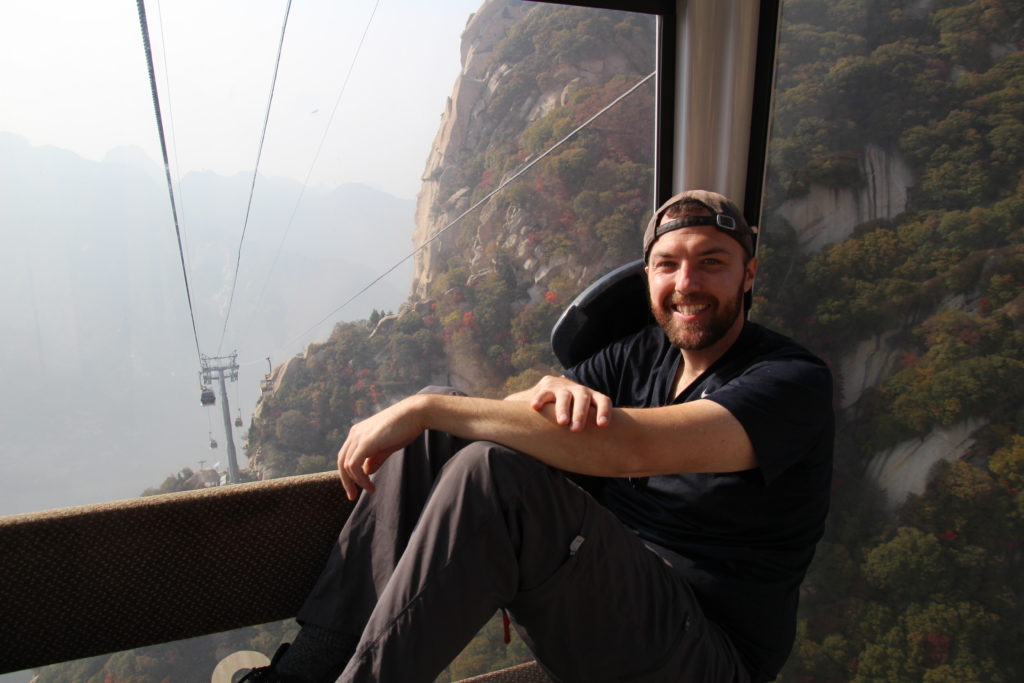
Enjoying the ride (we earned it!)
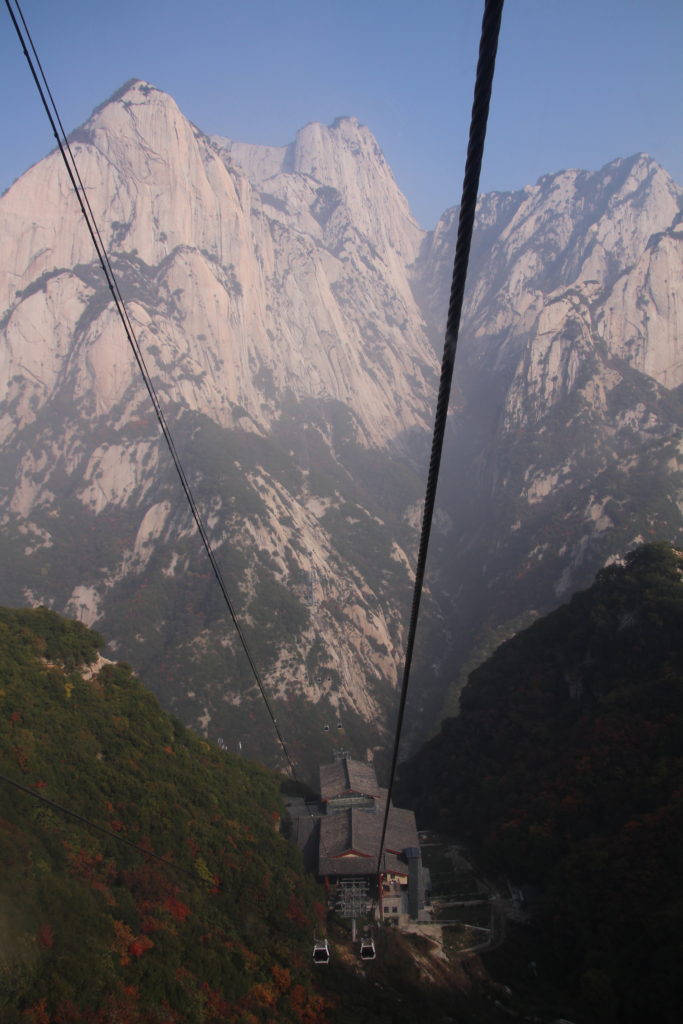
It really did look that steep in person, too. Pretty epic.
The top of the west peak of Huashan Mountain, where the cable car deposited us, provided a continuation of the views that awed us as we ascended the mountain. The topography of the mountain is beautiful, with steep and smooth rocks creating stunning cliffs dotted with trees, shrubs and enough other features to create a really unique setting. I’ve hike on mountains before ranging from Utah to Nepal, but the topography of these mountains was unlike any others I’ve seen. Truly rewarding.

One of the many stunning views from the hike.
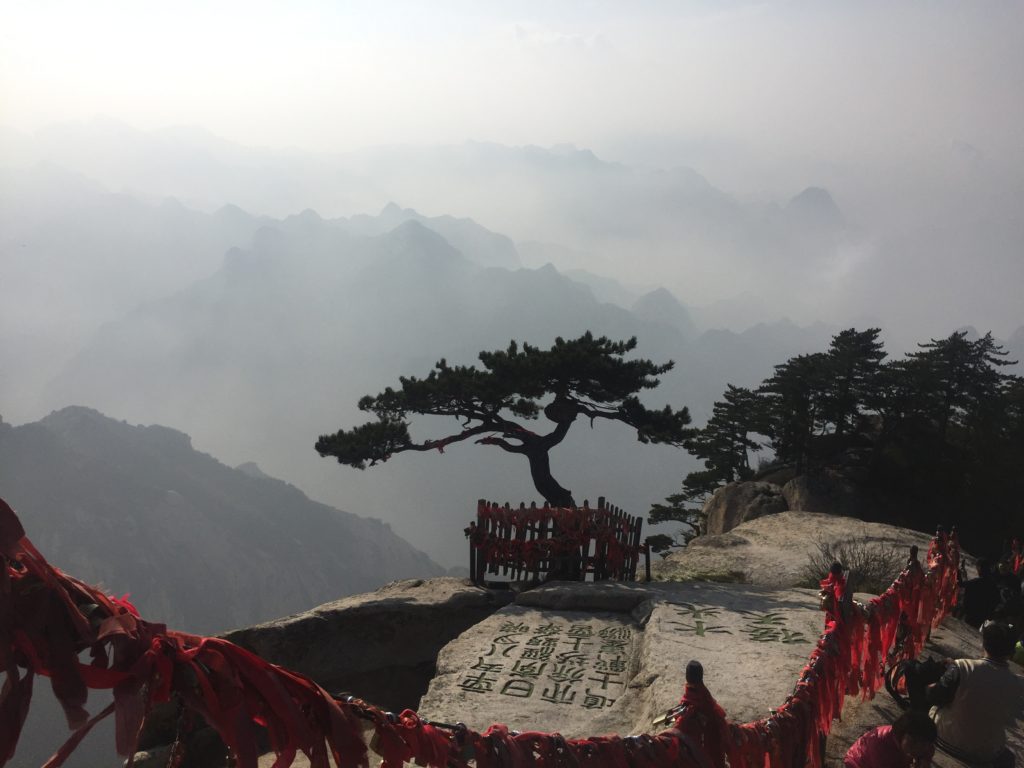
Chinese tourists buy metal locks and red ribbons and attach them to the railings all over the mountain.
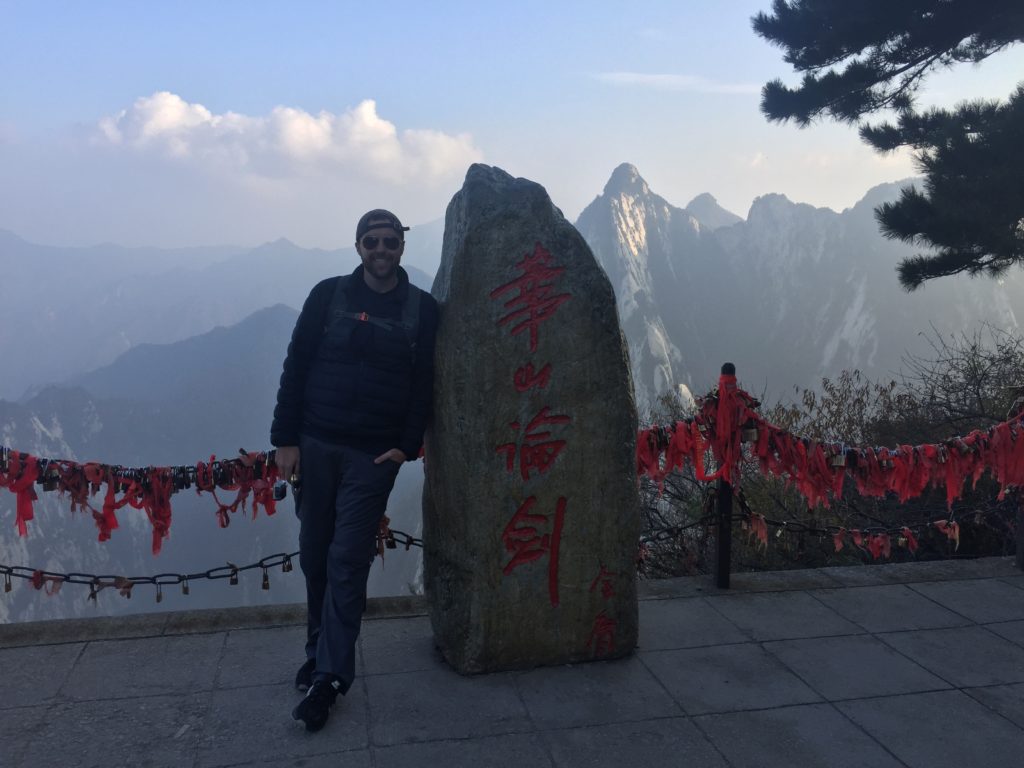
Rorie at the official marker for one of the 5 peaks.
Huashan Mountain is important in China because it has five peaks on the mountain and is perceived as being sacred for religious (Taoist) and cultural reasons in the country. Therefore, once you’re at the top of the mountain, it is common to hike between the five peaks – taking roughly 4-5 hours total – in order to enjoy the views and a brief respite from city life. The hiking was exhausting (it’s just all steep stone stairs, either going up or down) and made all the more ridiculous by the hordes of Chinese tourists who were also laboring through the efforts (they’re not terribly fit) and jostling for pictures in precarious situations.
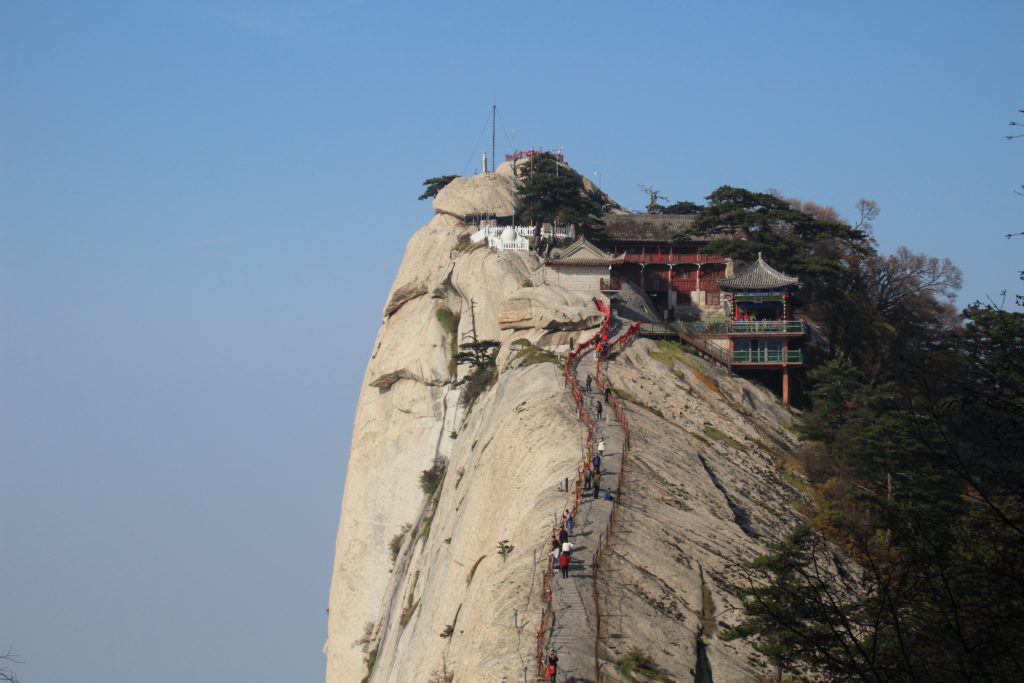
One of the peaks from a distance, with relatively few tourists on the path. Most areas were way more crowded.
Near the south peak of the mountain we reached the primary objective of our efforts: the death plank, which is a 2 foot wide wooden plank held together with rusty nails that wraps around the side of a cliff with no banister in sight that you stay on via a ragged harness and rusty carabiners. Despite being incredibly sketchy and dangerous (rumor has it that 100+ people die on the plank each year), we were eager to walk around and test our courage. Unfortunately, we arrived to find an extremely long line that was moving at a snail’s pace. Between the wait and the exceptional sketchiness of the venture, we decided to follow the cues of all the other westerners we ran into on the mountain and just skip the death plank – it simply wasn’t worth it. [Editor’s note: While most of what we’ve read calls it the Death Plank, on the mountain it’s labeled with the more marketable name “Sky Plank Walk”.] A bummer, but it fit in nicely with the numerous other disappointments/struggles of the day.
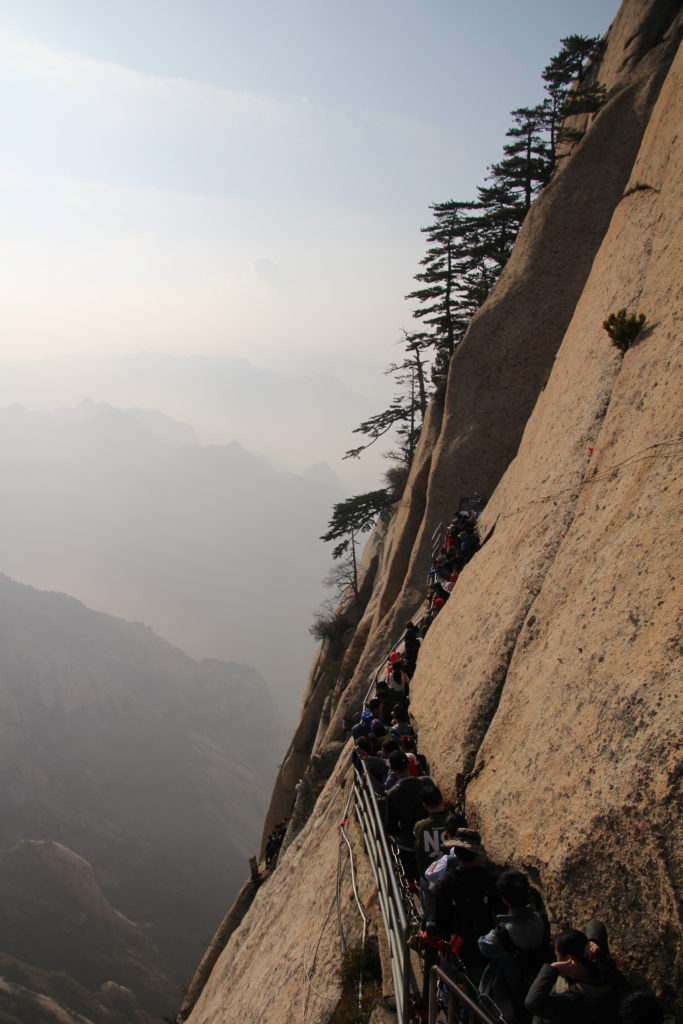
This is the line of people hanging off the side of the cliff waiting to do the Death Plank. No, not the plank itself. That part doesn’t have a railing and is barely visible lower down on the cliff from the line. This line wasn’t moving… no thanks.
The rest of the hike to the north peak – where the returning cable car was located – was mainly downhill (read: down steep stone stairs with only a rusty chain for a handrail), wreaking havoc on our knees and ankles but otherwise wasn’t too problematic. There’s not too much to write about there since our pictures should tell the story better than words can, or the rest of our logistics getting home, since they proved to be much smoother (we managed to figure it out, mercifully). Overall, the mountain was really beautiful/unique and the hiking was nice. I couldn’t honestly tell you if it was worth the hassle and cost (it was roughly $100/pp for everything we described, which is super expensive in China) involved, but it certainly wasn’t a complete bust as an experience. [Editor’s note: this last clause is typical Rorie hedging. I thought the mountain was beautiful and I’m glad we did it, though the logistics were really annoying. I’d recommend it as a day trip, but I’d also recommend being better prepared than we were to actually get there.]
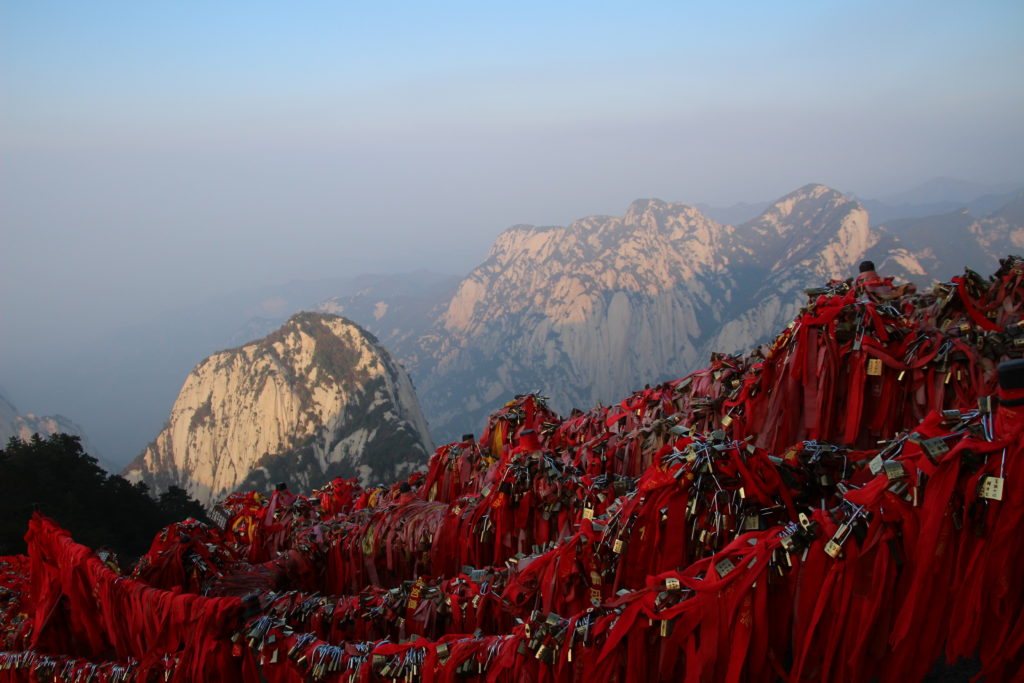
Rows of locks and ribbons and an incredible view.

One of the very few photos of both of us on the mountain.

Exceedingly steep stone stairs, with only rusty chains to hold onto.
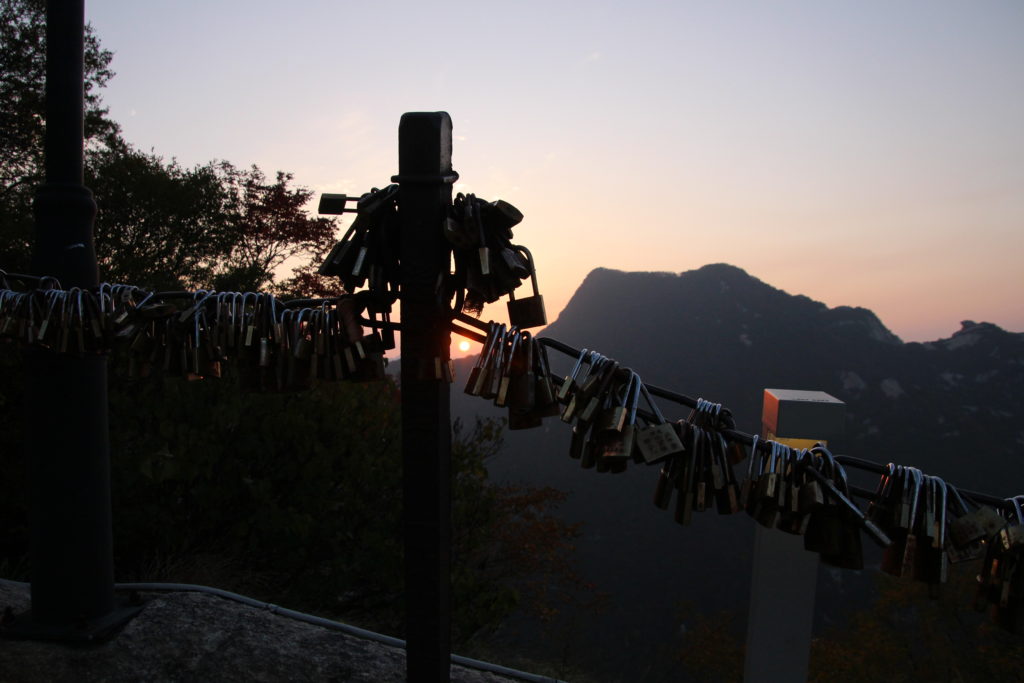
We were there late enough to catch the sunset over the peaks
Frankly, everything I described above made this one of the most difficult and frustrating travel days we’ve experienced in our initial 3 weeks of traipsing around the world. While they often happen on a smaller scale, these are typical of the obstacles that we confront every day when traveling. They simultaneously point to the fact that while it is occasionally glamorous (have you seen our awesome pictures?!), more often it is harder than anyone understands who just hears about it and thinks, “Wow, you guys are the luckiest people ever. I would SO do that. Sign me up!”
With that said, the numerous struggles we confront when traveling often generate, or coincide with, silver lining moments that allow us to look back with far more positive memories than would seem to be warranted. In this instance, it was the people. Weirdly enough, this hike of Huashan Mountain was really the first time we interacted with westerners extensively while in China, which really brought some light to our day. There was a Canadian family on the mountain whose paths kept crossing with ours, allowing us to swap laughs and stories as we all tried to navigate the experience. We ran into an extremely ebullient and talkative Spaniard who gave us a bunch of Chengdu tips (our next city), along with his quiet, contemplative German comrade. At the train station we met a professional female underwater hockey player (seriously, I guess it’s a thing) from Canada who was traveling solo and chatted with us for a while. Finally, we met a couple of Malaysian sisters (via Singapore) who spoke perfect English and Chinese who shared laughs/stories with us, while also helping us navigate our journey back to Xian.
All of these people disappeared from our lives just as quickly as they arrived, but they completely changed the tone of our day and managed to energize us as we were in the midst of a seemingly never-ending series of struggles and disappointments. We’re learning to focus on these silver linings as they arise, to savor them and to look forward to them as unexpected gifts from the backpacking gods.
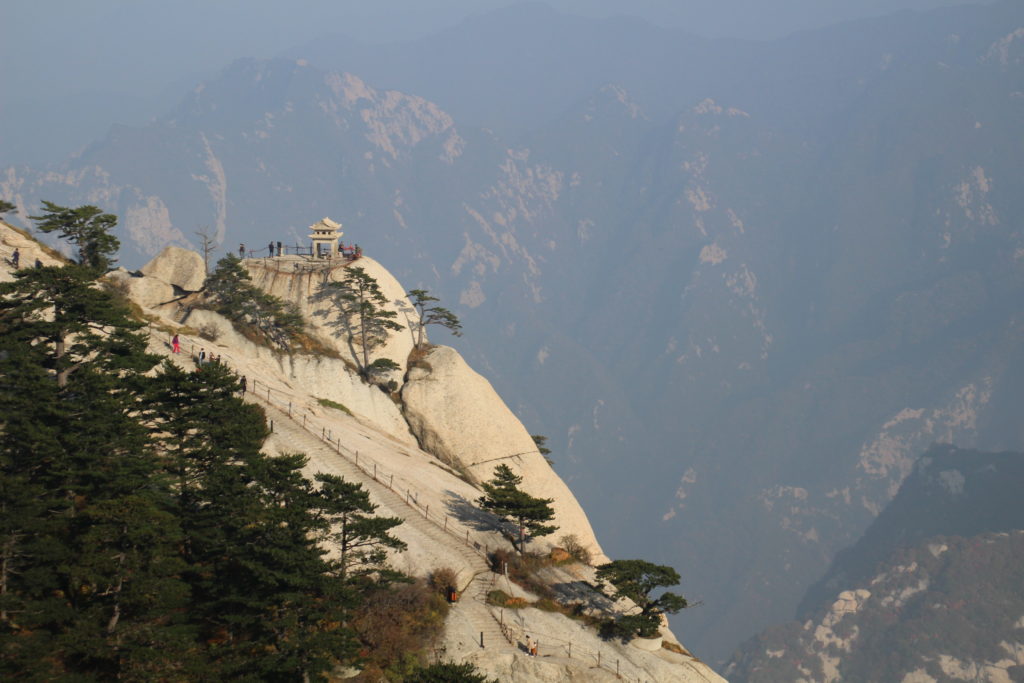
A small structure called the Chess Pavilion on top of an outcropping
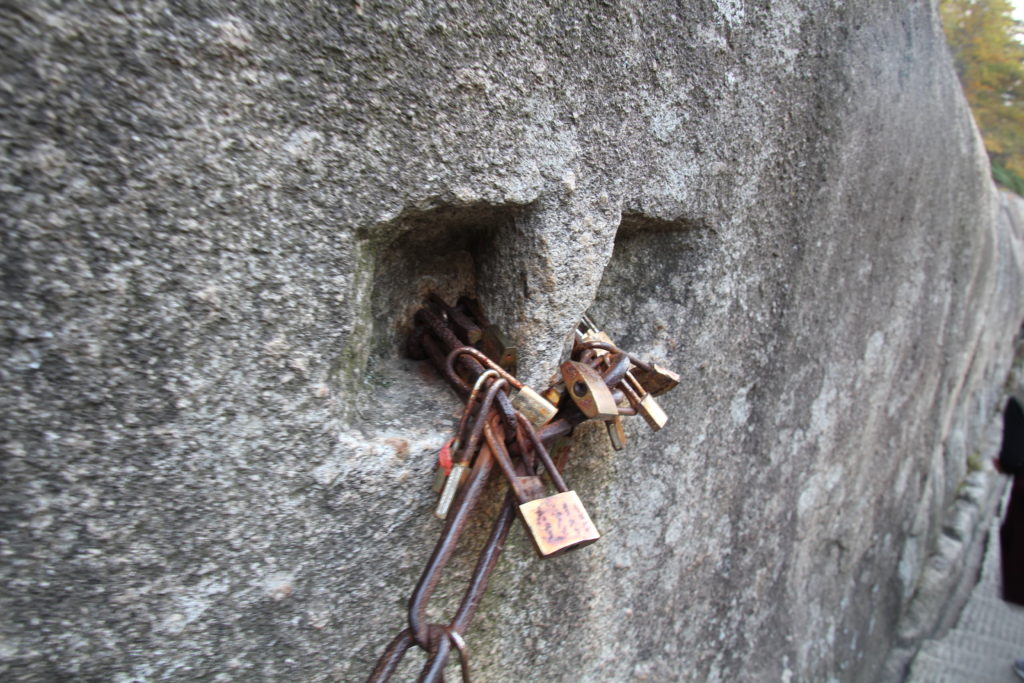
The railing attached to the rock by simply carving out the stone
